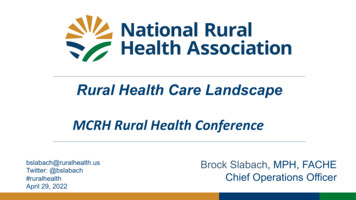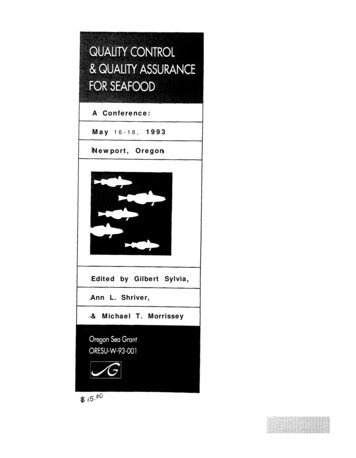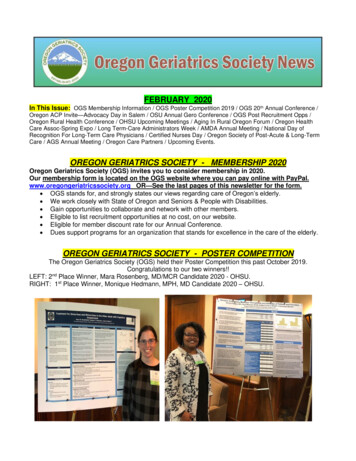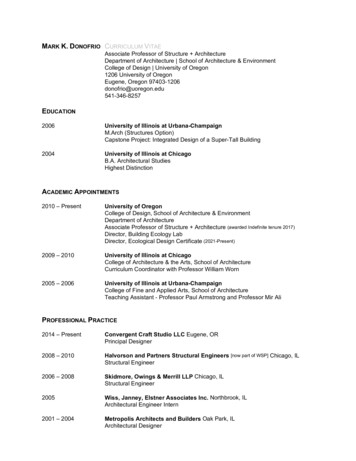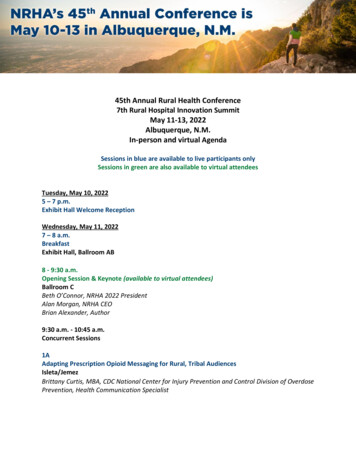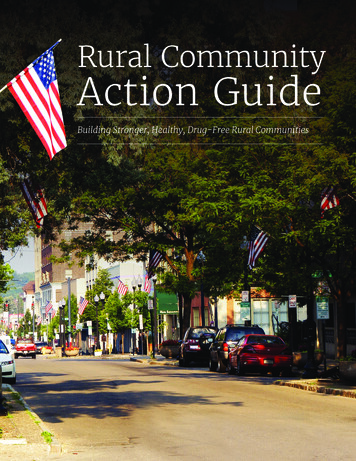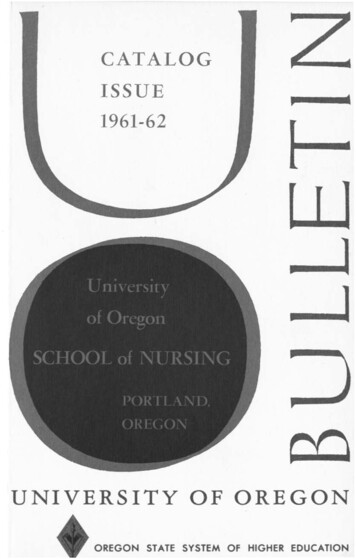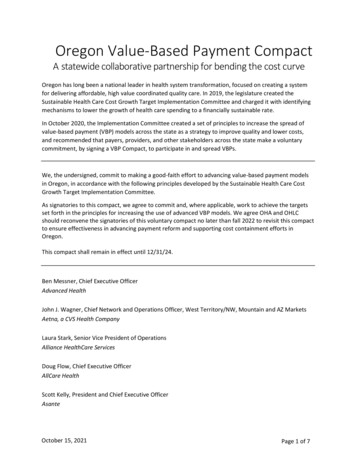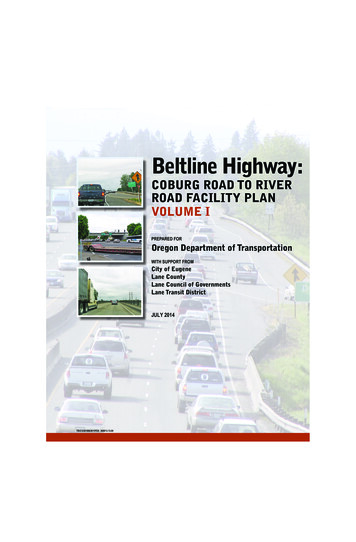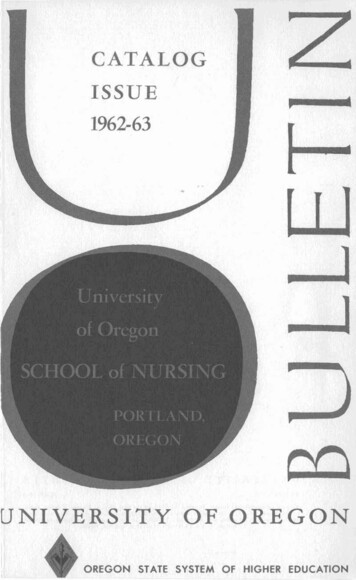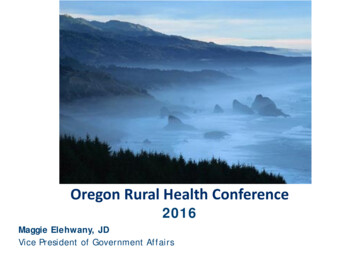
Transcription
Oregon Rural Health Conference2016Maggie Elehwany, JDVice President of Government Affairs
Change is coming again Election 2016 - What can we expect from a new Administrationand Congress? What will it mean forOregon rural health care?
We know some change is needed Hospital closures increase. Profits plummet for MANY rural hospitals. Rural/Urban divide continues to grow.
What impact will these two have?
Or these guys? Rural America: Disproportionately dependent onFederal Government. Medicare/Medicaid/regulatory impact
And what about Oregon’s delegation
Issues to be addressed by new CongressNot Election Dependent Chronic Disease Opioid Abuse Hospital Closure CrisisElection Dependent Degree of Changes to ACA– Premiums– Provider payments– Lack of insurance competition
Today Affordable Care Act - - What is it doing to/forrural America? What changes will the electionbring? What can we expect from a RepublicanCongress? A Democratic Congress?
Issues where weneed vigilance
Critical Rural Payments Set to ExpireNext Year Medicare Dependent Hospital (MDH) - 100million Low-Volume Hospital (LVH) - 450 million Work geographic index floor under the Medicarephysician fee schedule (GPCI) - 500 million All current ambulance payment rates includingrural and super rural- 100 million Exceptions process for Medicare therapy caps 1 billion Rural Home Health Add on Payments
New HPSA Designation CouldHave Significant ImpactOverview: HRSA to use new system – Shortage Designation ManagementSystem Goal - utilize more standardized provider data - - based on NPI (NationalProvider Identifier) HRSA is working on various impact analysis on changes in ShortageDesignation.– By May 2017, PCOs are to finish submitting provider data.– In June 2017, Second impact analysis, including Auto-HPSAs, provided tostakeholders by HRSA.– By July 2017, National update of all designations, including Auto-HPSAs. HRSA promising to fully review the impact on HPSAs and offer opportunitiesfor stakeholders to review the impact. NRHA forming a coalition of stakeholders -- wemust be vigilant! Much more to come!
CMS Star Rating July 27th CMS released Overall Hospital Quality StarRatings 20% of hospitals (937 facilities) do not meet theminimum data requirements to have a star ratingcalculated. The majority (671) of the facilities with no star ratingare CAHs.– “Not available” with a note that indicates “there are toofew measures or measure groups reported to calculate astar rating or measure group score.”
The Results 64 measures used in calculation.Star Rating Results One Star 133 (4%) Two Star 723 (20 %) Three Star 1770 (48%) Four Star 934 (25%) Five Star 102 (3%) Of the 540 CAHs that did have a Star Rating calculated, CMS founda higher average Star Rating among CAHs (mean 3.31) comparedto non-CAHs (mean 2.99). The range was generally from 2 to 4stars. Legislative response: legislation to delay implementation. NRHA Fight: Rural relevant measures meaningful in rural settings.
Transition to Transformation/Huge Impact of MACRA Sweeping changes to Medicare reimbursement for physicians - moving away from fee-for-service. Goal: tie increased reimbursements to merit-based system orAPMs. Hospitals’ impact: hospitals that employ physicians directly will beimpacted. Hospitals may also be called upon to participate in APMs.
Slavitt message to doctors: “Let’s be flexible!”September 8 letter, Slavitt specifically cites “ the unique issues facing smalland rural non-hospital-based physicians” as one of the reasons for creatingflexibility.Offers Four different Options:1. Test the Quality Payment Program.As long as you submit some data you will avoid a negative payment adjustment.2. Participate for part of the calendar year.You may choose to submit data for a reduced number of days. Allows you to stillqualify for a small positive payment adjustment.3. Participate for the full calendar year.For practices that are ready to go on January 1, 2017, -- allows a modest positivepayment adjustment.4. Participate in an Advanced Alternative Payment Model in 2017.Instead of reporting quality data you can participate in an Advanced APM.Possible to qualify for a 5 percent incentive payment in 2019.
Rural Health Disparities More likely to report fair to poor health Rural counties 19.5% Urban counties 15.6% More obesity Rural counties 27.4% VS urban counties 23.9% Less likely to engage in moderate to vigorous exercise: rural 44%VS urban 45.4% More chronic disease (heart, diabetes, cancer) Diabetes in rural adults 9.6% VS urban adults 8.4% Distances to access care are vast: 20% of population scattered over90% of landmass
46% of the land area of the United States as frontier, and over 5.6 million people lived inthese areas in 2010.
Workforce Shortages Only 9% of physicianspractice in rural America. 77% of the 2,050 ruralcounties are primary careHPSAs. More than 50% of ruralpatients have to drive 60 miles to receive specialtycare.
6th Anniversary of the Affordable Care Act The good, bad and not so pretty
Is ACA Working?September Numbers: Lowest uninsured rates in half acentury. Latest numbers - - U.S. Uninsured Rate is 8.6%
Does an access issue remain?1. Exchangesa. Premium increaseb. Lack of choicec. High deductible2. Medicaid - - non-expansionstates.
Are Health Exchanges Working inRural Areas? 58.3% of rural counties onlyhad 1 or 2 plan options 23.7% of rural counties vs.5.5% of urban counties hadonly 1 plan option Over ¾ of urban plans hadthree or more choices ofcoverageRural areas appear to have lower rates of planselection, suggesting that improving outreach andenrollment efforts in these communities may beparticularly warranted.Sept. 2014
Unanticipated “Millions are now being covered through the law, butthey're older, sicker and more expensive to insure thananyone anticipated. To compensate, health plans areraising premiums, in some cases by a lot—the largestinsurer in Texas wants to jack up rates for individualplans by an eye-popping 60 percent next year.”Politico, July 2016 Most insurers lost money the first year of operations(2014); insurers underestimated medical claims by5.7%.
Insurance companies drop out, spike rates “Largest Insurer Pulls out of ObamaCare Exchanges” “UnitedHealth Group – No longer participates in a majority of exchanges; limits plansto just a “handful” of states in 2017 and is “evaluating the viability” in the future.” U.S.News and World Report April, 2016 “Aetna, Coventry Back out of State Exchanges” - - 834,000 will losecoverage from Aetna alone. Blames higher than expected medicalclaims.Atlanta Constitution, July 2016 “Another Major Insurer May Leave Obamacare’s Exchanges”Health Care News, March 2016 “Humana Seeks 50% ObamaCare Premium Hike in Michigan”Investors Business Daily, March, 2016
One insurer UnitedHealth Group Largest health insurer in nation will exit 34exchanges; Expects to lose 650 million this year on itsObamacare business; HOWEVER: The individual insurance market isa small piece of UnitedHealth's overallbusiness. The company had profits of 3.2billion on 46.5 billion in revenues during thesecond quarter, beating expectations.
“Insurance Options Dwindle inRural Regions”Wall Street Journal May, 2016 ALASKA, ALABAMA, KENTUCKY, ARIZONA ANDOKLAHOMA MAY HAVE JUST ONE INSURER IN ACAEXCHANGE. The Kaiser Family Foundation estimates that one inthree counties have only one plane. Rural regions,counties, and states are more likely to have singleinsurer markets than metro areas and have fastergrowing premiums. In fact: 70 percent of the counties that insurershave pulled out have populations that are mostlyrural.
Co-Op Collapse 23 co-ops received significant federal money to offerhealth care plans in the exchanges. Nine. That's how many co-ops are still in business.
The Oregon Plan and Oregon ExchangesExchanges Struggle Oregon lost two health care providers from the exchanges last yearincluding Health Republic, a failed co-op that went belly up after 20million in losses. Oregon’s BCBS plan reported a loss of 12.7 million in just the firstquarter of this year. In fact, there’s only one insurer in Oregon operatingin the black.Oregon Plan - - Medicaid Waiver and Coordinated Care OrganizationsExpansion approved. CCOs show innovation and potentialDENTAL COVERAGE: More innovation is needed - - must better integrate inprimary care.
Oregon gubernatorial debate:urban/rural divide focus
Medicaid and Rural Impact Fewer rural states have expanded Medicaid. A majority of the states with the largest percentage of populationliving in rural areas are not expanding, while nearly all of the leastrural states are expanding. States with a higher percentage of their rural population living inpoverty are less likely to expand. The majority of rural residents livein a state without plans to expand Medicaid. Only three of the 11 states with the largest rural population haveexpanded their Medicaid programs (IA, KY, MI).
Rural Health Clinics Advocacy Rural Health Clinic across ruralAmerica face long-standingchallenges of inadequatereimbursement rates, workforceshortages and technologychallenges.
RHCs - Sequestration cuts continue Amount allowed: 80% Medicare Payment of All-inclusive Rate: 2% Sequestration on Medicare share: Net payment from Medicare: 79.17 63.84 1.28 62.56 Net Payment decrease from Medicare is1.62% of capitated rate.
Reimbursement under newreporting requirement troubling2015 Physician Fee Schedule Final Rule: April 1, RHCs required to report Healthcare Common ProcedureCoding System (HCPCs) Included RHCs exempt from electronic reporting. When it was rolled out -- it was unnecessarily complex anddisruptive to RHC billing processes MACs were not prepared. Significant payment delays - - cause significant harm to RHCs. October 1, more billing phases set to begin - - Will CMS be ready?
RURAL HOSPITAL CLOSURES
The latest casualty in rural hospital closure crisis Closed July 1, 2016. The hospital is theonly one in Scott County, Tennessee.The facility sees around 25 to 30patients in the emergency room eachday and 30 outpatients.
Rural Hospital Closures and Risk of Closures76XPercent Vulnerable35%
For immediate releaseFeb. 2016New report indicates 1 in 3 rural hospitals at riskNew research indicates that sustained Medicare cuts threatenthe financial viability of more than one-third of rural hospitals inAmerica.Of the 673 hospitals identified as vulnerable to closure, 355 arein markets with great health disparities. In other words, manyof the hospitals most at risk of closure are located incommunities that can least afford to lose access to care.
Rural Hospital Closures: 1983-97
RURAL Hospital Closures Escalating72 Hospitals have closed since 2010.The VULNERABILITY INDEX identifies 673Rural Hospitals Now Vulnerable or At Risk ofClosure673210 hospitals are most vulnerable to closure,while an additional 463 are less vulnerable76since 2010Rural hospitals closing wherehealth disparities are the greatest.
Rural Hospital Closures on the RiseClosures25At this rate,25% of ruralhospitals willshut down inless than10 years .201510502010 2011 2012 2013 2014 2015 2016 2017*Even if legislative action is taken today, if it takes as long to implement the Community OutpatientHospital as it took from the implementation of the CAH from a demo to the first certified CAH (10years), 485 hospitals will be closed.
Chris Smiley, Sac-Osage Hospital's last chief executive, stands in the empty emergency room. The Osceola,Missouri, hospital closed after 45 years of serving the rural communities of western (April 2015)
The Impact of 76 Closures 10,000 rural jobs lost. 1.2 million rural patients who have lost accessto their nearest hospital.
“When rural hospitals close,towns struggle to stay open.”Marketplace, April 2014
“Rural hospitals and the rural economy riseand fall together”“Three years after a ruralhospital community closes, itcosts about 1000 in percapita income.”Mark Holmes, professor, Universityof North Carolina On average, 14% of total employmentin rural areas is attributed to the healthsector. Natl. Center for Rural HealthWorks. (RHW) The average CAH creates 107 jobs andgenerates 4.8 million in payrollannually. (RHW) Health care often represent up to 20percent of a rural community'semployment and income. (RHW) Medical deserts form in ruralcommunities where hospitals close.
Policy Consequences Impact Rural Hospitals*69% of Rural Hospitals have a negative OPERATING profit margin.47
Rural Hospitals Losing MoneyEscalatingMedPAC March 2016 report:Medicare Margins: NEGATIVE 9%
New Study: ACA and the FinancialPerformance of Rural HospitalsNC RuralHealth Research Center, July 19, 2016 “ the ultimate financial impact of the ACA on rural hospitalproviders is still unknown.” “The ACA’s expansion of insurance coverage has affecteduncompensated care, unreimbursed cost, and financialperformance in rural hospitals.” Despite expanded insurance coverage “few (rural hospitals)reported a positive net financial impact as a result of theACA’s expanded insurance coverage — primarily becauserespondents felt that bad debt from high-deductible healthplans and shortfalls between payments and costs of care inMedicare and Medicaid were growing.”
Impact of Sequestration 2.8 billionlost in rural Medicarereimbursement (over 10 years)2%cut7,200jobs lost in rural hospitals andcommunities (sustained over 10years)-0.6%off the bottom line30rural hospitals shifting fromprofitable to unprofitable
Impact of cuts in Bad DebtReimbursement 1 billionlost in bad debt reimbursement(over 10 years)35%cut2,000rural healthcare jobs lost2,600rural community jobs lost 5.3 billionloss to GDP(over 10 years)
Save Rural Hospitals Act, HR 3225 –34 cosponsorsRural hospital stabilization (Stop the bleeding)– Elimination of Medicare Sequestration for rural hospitals;– Reversal of all “bad debt” reimbursement cuts (Middle Class Tax Relief and Job Creation Act of 2012);– Permanent extension of current Low-Volume and Medicare Dependent Hospital paymentlevels;– Reinstatement of Sole Community Hospital “Hold Harmless” payments;– Extension of Medicaid primary care payments;– Elimination of Medicare and Medicaid DSH payment reductions; and– Establishment of Meaningful Use support payments for rural facilities struggling.– Permanent extension of the rural ambulance and super-rural ambulance payment.Rural Medicare beneficiary equity.(total charges vs. allowed Medicare charges.)Eliminate higher out-of pocket charges for rural patientsRegulatory Relief– Elimination of the CAH 96-Hour Condition of Payment (See Critical Access Hospital ReliefAct of 2014);– Rebase of supervision requirements for outpatient therapy services at CAHs and rural PPSSee PARTS Act);– Modification to 2-Midnight Rule and RAC audit and appeals process.Future of rural health care (Bridge to the Future)Innovation model for rural hospitals who continue to struggle.
Future Model: Community Outpatient Model 24/7 emergency Services Flexibility to Meet the Needs of Your Community through OutpatientCare: Meet Needs of Your Community through a Community Needs Assessment:Rural Health ClinicFFQHC look-a-likeSwing bedsNo preclusions to home health, skilled nursing, infusions services observation care.TELEHEALTH SERVICES AS REASONABLE COSTS.—For purposes of this subsection, with respect toqualified outpatient services, costs reasonably associated with having a backup physician available via atelecommunications system shall be considered reasonable costs.”. “The amount of payment for qualified outpatient services is equal to 105percent of the reasonable costs of providing such services.” 50 million in wrap-around population health grants.
New Grants Available to CAHsand Rural PPS Hospitals 12 million appropriated annually for QualityImprovement and Compliance Grants. 15 million appropriated annually for ruralpopulation health needs. 2 MILLION EMS GRANT FUNDING — todevelop EMS programs to meet communityneeds, address workforce and fundingproblems. For COHs - 50 million in grant funding.
The Save Rural Hospitals Act – JoinNRHA efforts. SRHA is not a bill just for rural hospitals that struggle. SRHA will mean millions of dollars to your facility. SRHA will offer key regulatory relief.Current Status House: Introduced - - Reps. Graves (R-MO) , Loebsack(D-IA), July 31, 2015. Senate: Not yet introduced. We need you grassroots efforts. We need your hospitalboards and your community to be involved.
Even MedPAC recognizes thatrural hospitals are struggling June 2016 Report “Improving Efficiency and PreservingEmergency Access to Emergency Care in Rural Communities. “Average Medicare margins are negative, and under currentlaw they are expected to decline in 2016.” When CAHs face a decline in the number of private insurers,they face financial difficulties despite receiving cost-basedMedicare reimbursement. Medicare may achieve greater efficiency and financial stabilityat some rural hospital by subsidizing emergency services ratherthan inpatient care. New HRSA report backs up the need for supplementalpayments for emergency care.
A Rural Divide in American Death Mortality is tied to income and geography. Minorities, especially Native Americans die consistently prematurely nation-wide,but more pronounced in rural. New study: startling increase in mortality of white, rural women. Causes:–––Risky lifestyle (smoking, alcohol abuse, opioid abuse, obesity)Environmental cancer clusterssuicides Since 1999, 650,000 rural individuals have dies prematurely – that’s equivalent tothe death toll of the Civil War. In major cities life expectancies continue to expand.
Opioid Crisis in Rural AmericanAll states have demonstrated an increase in nonmedical prescription opioidmortality during the past decade, however, the largest areas of abuse areconcentrated in states with large rural populations, such as Kentucky, WestVirginia, Alaska, and Oklahoma.
Last Week: National OpioidEpidemic Week Ag Secretary Tom Vilsack yesterday announced 4.7 million to 18 different distance learning andtelemedicine projects, intending to expand opioidtreatment in rural areas. Hundreds of millions in grant dollars in recentlypassed CARA.- NRHA fought for language to prioritize rural areas. Oregon: More drug overdose deaths involveprescription opioids than any other type of drug.
The Seinfeld Congress Congress setting new bar for doing nothing. Election year usually means little gets done onCapitol Hill but “Congress seems to be settinga new bar for unproductiveness.”
Congressional SpendingAPPROPRIATIONS MOREIMPORTANT THAN EVER.Some appropriations bill completed but most not; battle over acontinuing resolution which will ultimately mean level spending.
Battle for the Senate The current U.S. Senate has 54 Republicans and 45 Democrats(including one independent). There are 34 Senate seats up in 2016, of which 24 are held byRepublicans. Democrats will need to gain 4 or 5 seats to takecontrol.Seats up for electionDemocratsRepublicans
Senate Races to WatchARIZONA – LEANS RCOLORADO – LIKELY DFLORIDA – LEANS RILLINOIS - LEANS D – (SWITCH) – SEN. KIRK IN TIGHT RACE.INDIANA – LEANS D (SWITCH) – OPEN SEAT/COATS RETIREMENTMISSOURI – LEANS RNEVADA – TOSS UP – OPEN SEAT/REID’S RETIREMENTNEW HAMPSHIRE – TOSS UPNORTH CAROLINA – LEANS ROHIO – LEANS RPENNSYLVANIA - TOSS UPWISCONSIN – LEANS D (SWITCH) – SEN. JOHNSON IN TIGHT RACE
But does it really matter?Democrats - Build and expand Affordable Care ActRepublican Overview – “A Better Way”
What we do now! Meet with key committees - - Oregon is important! Meet with Senate Rural Caucus Meet with transition teams of both possible newadministrations Activate grassroots during Congressional recess! Election year to best time to get involved.
THANK YOU!GO DUCKS!GO BEAVS!
Oregon Rural Health Conference. 2016. Maggie Elehwany, JD. Vice President of Government Affairs. . Oregon rural health care? . Rural Home Health Add on Payments. New HPSA Designation Could Have Significant Impact Overview: HRSA to use new system - Shortage Designation Management .
